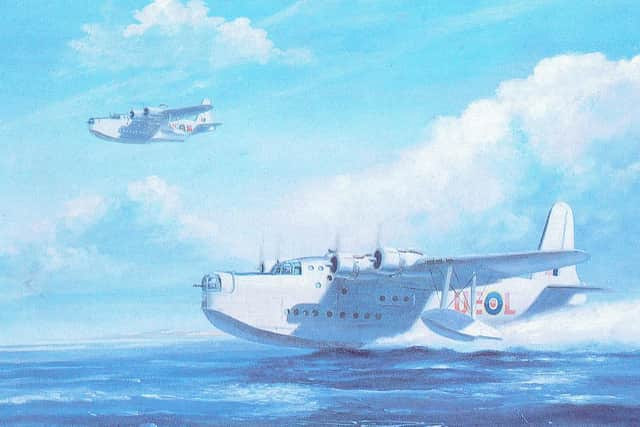a
and live on Freeview channel 276
Life on a Flying Boat Station by Brian Cranwell RAF (1950-53)
In 1951, as a newly qualified Radar Mechanic I was posted to RAF Marham in Norfolk where USA B29 bombers were stationed. I was to go through a six week conversion course for servicing American radar.
Advertisement
Hide AdAdvertisement
Hide AdI enjoyed my time there as I was able to play softball with the Yanks and could get things from them that were unobtainable in our shops or NAAFI.


But in typical Services fashion as soon as I completed the course I was posted to RAF Pembroke Dock to work on Sunderland Flying Boats. These were the oldest operational aircraft still in service with some of the oldest radar, designed for air/sea search.
They were great to work on, like messing about in boats, and as they had plenty of space on board including a galley and bed bunks, they would frequently carry a mechanic on board.
One strict requirement was that there had always to be a serviceable aircraft on standby in case of an emergency air-sea rescue need. I was on servicing duty New Year’s Eve 1952 when the duty squadron landed late and the standby aircraft (C for Charlie) had a fault on its radar. So two of us went out on a launch to this aircraft to service it.
Advertisement
Hide AdAdvertisement
Hide AdWe had been working for about an hour and a half and had just located the fault when we heard a launch arrive.
Some noise on the steps up to the flight deck from the galley revealed the Flight Sergeant in charge of the Radar Servicing Section, ‘Chiefy’ McGrath.
He had been at the sergeant’s mess New Year’s Eve party and had clearly had a few drinks, when he obviously felt it his duty to make sure we were managing.
“What’s the score, fellas?” he asked in his broad Irish accent. We reassured him that we had located the fault and would probably not be long before finishing.
Advertisement
Hide AdAdvertisement
Hide Ad“Good work lads,” he said, “I’ll, leave you to it”. He stayed a few more minutes then climbed back down from the flight deck. We heard the launch take off back to shore.
After about 30 minutes, when we had finished, we connected up the Aldis Signal lamp and flashed the control tower. They sent the launch out, we locked up the aircraft and went ashore.
After seeing the New Year in the NAAFI, I went to bed.
At about 2am I was woken up by an RAF policeman. “Are you SAC Cranwell?” he asked.
I affirmed this, so he continued “Who the b….y hell have you left out on C for Charlie? Someone’s been signalling from there to the control tower. Get out there and find out. We’ve got a launch on standby”.
Advertisement
Hide AdAdvertisement
Hide AdWhen I reached the aircraft it turned out that, although we had heard the launch leave after Chiefy had said “goodnight”, he had decided to wait for us, told the launch crew to go back, laid down on a bunk and fallen asleep.
Although it was cold he had on a woollen sweater and a heavy overcoat. The bunks were out of sight of the aircraft door by the galley so we had thought he was on the launch, and, as the crew had changed when we went ashore, the replacement crew did not realise he had been there.
When he awoke in the pitch black he realised there was nobody else there. He had to feel his way up to the flight deck, find the Aldis lamp and plug it into its socket, all in the dark, and signal Control. As Control did not expect anyone to still be out on the water it took some time before anyone noticed.
Chiefy’s language on seeing us was choice, as he was freezing cold by this time.
Advertisement
Hide AdAdvertisement
Hide AdTo give him his due, Chiefy never actually blamed us, but I did find myself on what seemed rather more extra duties than normal for a month or so.
But my fond memories of my time on this station remain, together with a nostalgic fondness for the Flying Boats.